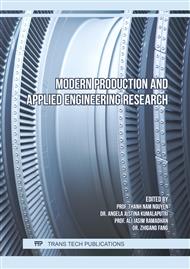[1]
R. Arif, A. Khitab, M.S. Kirgiz, R.B.N. Khan, S. Tayyab, R.A. Khan, W. Anwar, M.T. Arshad, Experimental analysis on partial replacement of cement with brick powder in concrete, Case Stud. Constr. Mater. 15 (2021).
DOI: 10.1016/j.cscm.2021.e00749
Google Scholar
[2]
F. Cao, Z. Wei, C. Wang, Z. Fang, Frost Resistance of Wet-Mixed Plastering Mortar Prepared by Full-Component Recycled Sand, Journal of Shenyang Jianzhu University. 37(1) (2021) 131-137.
Google Scholar
[3]
G.M. Chen, Z.H. Lin, L.G. Li, J.L. He, A.K.H. Kwan, Compressive Behavior of Concrete Incorporating Clay Brick Fines Added by Paste Replacement Method, J. Mater. Civ. Eng. 33(7) (2021).
DOI: 10.1061/(asce)mt.1943-5533.0003752
Google Scholar
[4]
B. Cui, B. Gao, Q. Li, H. Kang, Iop, Experimental study on compressive strength and durability of steel slag cement non-burned and non-steamed brick, 2nd International Conference on Civil Engineering, Environment Resources and Energy Materials, Changsha, PEOPLES R CHINA, 2020.
DOI: 10.1088/1755-1315/634/1/012119
Google Scholar
[5]
E.T. Dawood, M.S. Mahmood, Production of Sustainable concrete brick units using Nano-silica, Case Stud. Constr. Mater. 14 (2021).
DOI: 10.1016/j.cscm.2021.e00498
Google Scholar
[6]
J. Fan, Z. Wang, G. Li, Preparation, Properties and Microstructure of Non-Calcination Rock Powder Brick with Orthogonal Experiments, APPL. SCI-BASEL. 11(21) (2021).
DOI: 10.3390/app112110274
Google Scholar
[7]
A. Grellier, D. Bulteel, M.E.K. Bouarroudj, S. Remond, Z. Zhao, L. Courard, Alternative hydraulic binder development based on brick fines: Influence of particle size and substitution rate, J. Build. Eng. 39 (2021).
DOI: 10.1016/j.jobe.2021.102263
Google Scholar
[8]
R. Harbi, R. Derabla, Z. Nafa, RESISTANCE TO SEAWATER OF A NEW CEMENT MORTAR BASED ON ADDITIONS OF RECYCLED PRODUCT, Civil and Environmental Engineering Reports 31(4) (2021) 249-271.
DOI: 10.2478/ceer-2021-0060
Google Scholar
[9]
Z. He, A. Shen, H. Wu, W. Wang, L. Wang, C. Yao, J. Wu, Research progress on recycled clay brick waste as an alternative to cement for sustainable construction materials, Constr. Build. Mater. 274 (2021).
DOI: 10.1016/j.conbuildmat.2020.122113
Google Scholar
[10]
G. Lee, J.H. Park, K.V.A. Pham, C.H. Lee, K. Lee, Experimental Investigation of Traditional Clay Brick and Lime Mortar Intended for Restoration of Cultural Heritage Sites, APPL. SCI-BASEL. 11(13) (2021).
DOI: 10.3390/app11136228
Google Scholar
[11]
C. Liu, T. Hu, H. Liu, W. Yu, H. Hu, Effect of Recycled Composite Micro-powder on Mechanical Properties and Microstructure of Concrete, J. Build. Mat. 24(4) (2021) 726-735.
Google Scholar
[12]
Q. Liu, J. Xiao, A. Singh, Quantification of plastic shrinkage and cracking in mortars containing different recycled powders using digital image correlation technique, Constr. Build. Mater. 293 (2021).
DOI: 10.1016/j.conbuildmat.2021.123509
Google Scholar
[13]
I. Luhar, S. Luhar, M.M.A.B. Abdullah, M. Nabialek, A.V. Sandu, J. Szmidla, A. Jurczynska, R.A. Razak, I.H.A. Aziz, N.H. Jamil, L.M. Deraman, Assessment of the Suitability of Ceramic Waste in Geopolymer Composites: An Appraisal, Mat.14(12) (2021).
DOI: 10.3390/ma14123279
Google Scholar
[14]
C. Mano, A. Thongtha, S. Maneewan, C. Punlek, Improvement of the thermal efficiency of autoclaved aerated concrete by black powder, Sci. Asia. 47 (2021) 76-+.
DOI: 10.2306/scienceasia1513-1874.2021.s015
Google Scholar
[15]
R. Maria Tremino, T. Real-Herraiz, V. Letelier, J. Marcos Ortega, Four-years influence of waste brick powder addition in the pore structure and several durability-related parameters of cement-based mortars, Constr. Build. Mater. 306 (2021).
DOI: 10.1016/j.conbuildmat.2021.124839
Google Scholar
[16]
J. Ni, X. Hu, F. Liu, C. Zhu, M. Li, J. Jin, C. Gou, Cement replacement with brick powder and concrete powder in sludge solidification, Mar. Georesour. Geotechnol. (2021).
DOI: 10.1080/1064119x.2021.1930299
Google Scholar
[17]
X. Ouyang, L. Wang, J. Fu, S. Xu, Y. Ma, Surface properties of clay brick powder and its influence on hydration and strength development of cement paste, Constr. Build. Mater. 300 (2021).
DOI: 10.1016/j.conbuildmat.2021.123958
Google Scholar
[18]
K. Pasupathy, S. Ramakrishnan, J. Sanjayan, Formulating eco-friendly geopolymer foam concrete by alkali-activation of ground brick waste, J. CLEAN. PROD. 325 (2021).
DOI: 10.1016/j.jclepro.2021.129180
Google Scholar
[19]
H.R. Kumavat, N.R. Chandak, D.J. Jadhav, Utilization of Clay Brick Waste Powder for Partial Replacement with Cement in Cement Mortar, Springer Singapore, Singapore, 2020, pp.95-103.
DOI: 10.1007/978-981-15-2806-4_11
Google Scholar
[20]
P.S. Cavdar, U. Cavdar, The evaluation of different environments in ultra-high frequency induction sintered powder metal compacts, Revista De Metalurgia. 51(1) (2015).
DOI: 10.3989/revmetalm.036
Google Scholar
[21]
Q. Zhao, C. Cui, B. He, X. Ding, Investigation of the mechanism of slow hydration in low w/c ratio RPC matrix under long-term autoclaved curing, Constr. Build. Mater. 237 (2020).
DOI: 10.1016/j.conbuildmat.2019.117660
Google Scholar
[22]
N. Sathiparan, Utilization prospects of eggshell powder in sustainable construction material-A review, Constr. Build. Mater. 293 (2021).
DOI: 10.1016/j.conbuildmat.2021.123465
Google Scholar
[23]
M.U. Shah, M. Usman, M.U. Hanif, I. Naseem, S. Farooq, Utilization of Solid Waste from Brick Industry and Hydrated Lime in Self-Compacting Cement Pastes, Mat. 14(5) (2021).
DOI: 10.3390/ma14051109
Google Scholar
[24]
U. Sharma, N. Gupta, K.K. Saxena, Comparative study on the effect of industrial by-products as a replacement of cement in concrete, 11th International Conference on Materials, Processing and Characterization (ICMPC), Indore, INDIA, 2020, pp.45-51.
Google Scholar
[25]
M. Sufian, S. Ullah, K.A. Ostrowski, A. Ahmad, A. Zia, K. Sliwa-Wieczorek, M. Siddiq, A.A. Awan, An Experimental and Empirical Study on the Use of Waste Marble Powder in Construction Material, Mat. 14(14) (2021).
DOI: 10.3390/ma14143829
Google Scholar
[26]
M. Szelag, Intelligent prediction modeling of the post-heating mechanical performance of the brick powder modified cement paste based on the cracking patterns properties, Case Stud. Constr. Mater. 15 (2021).
DOI: 10.1016/j.cscm.2021.e00668
Google Scholar
[27]
M. Szelag, J. Styczen, R. Fediuk, R. Polak, Properties and Strength Prediction Modeling of Green Mortar with Brick Powder Subjected to a Short-Term Thermal Shock at Elevated Temperatures, Mat. 14(21) (2021).
DOI: 10.3390/ma14216331
Google Scholar
[28]
Y. Zhao, J. Gao, C. Liu, X. Chen, Z. Xu, The particle-size effect of waste clay brick powder on its pozzolanic activity and properties of blended cement, J. CLEAN. PROD. 242 (2020).
DOI: 10.1016/j.jclepro.2019.118521
Google Scholar


